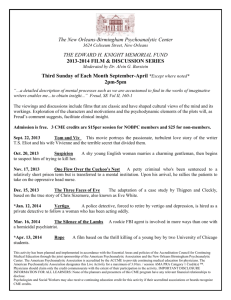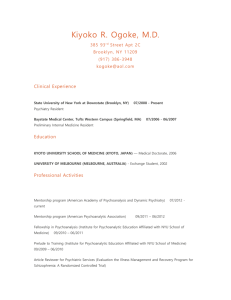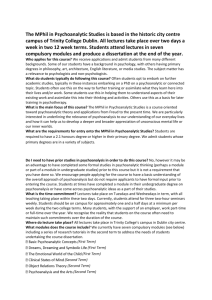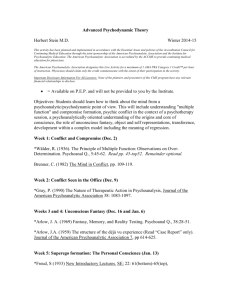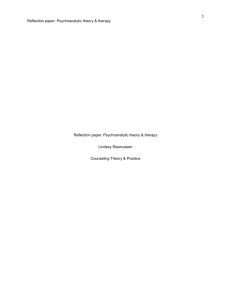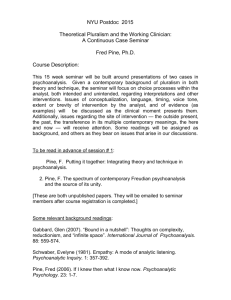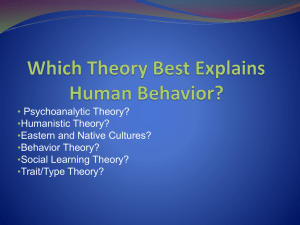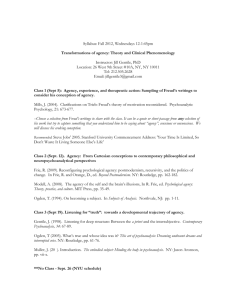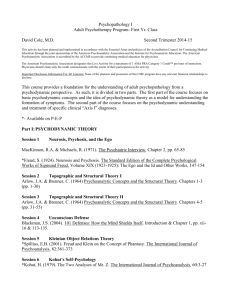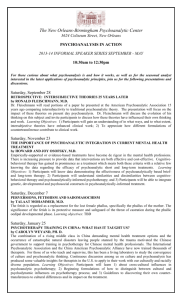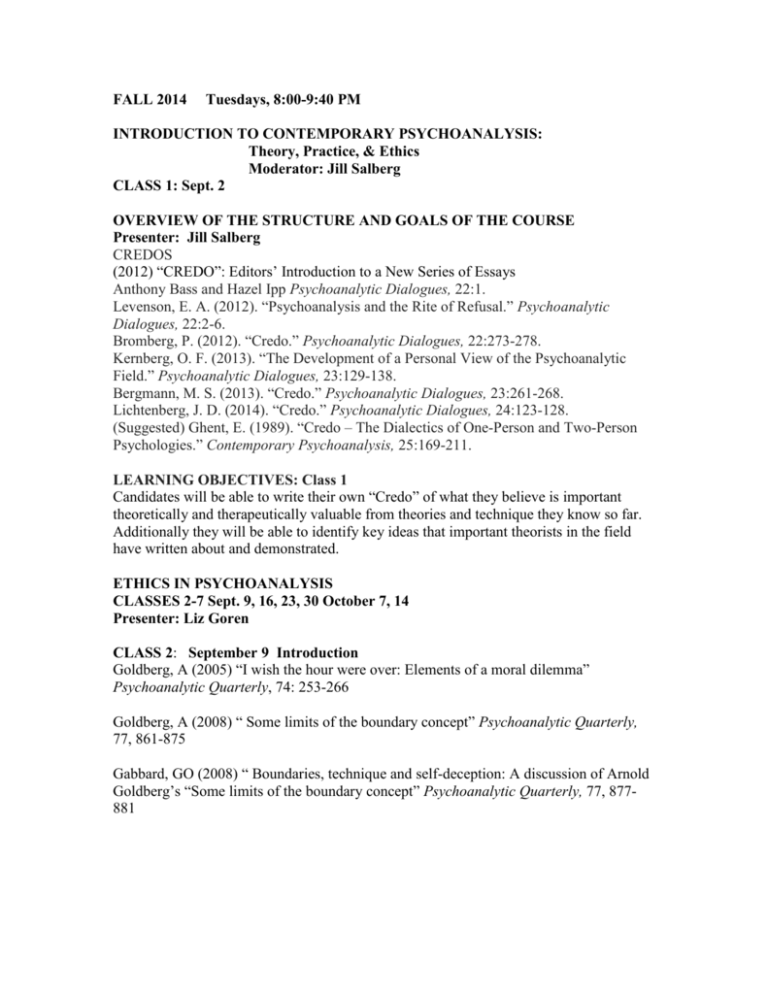
FALL 2014
Tuesdays, 8:00-9:40 PM
INTRODUCTION TO CONTEMPORARY PSYCHOANALYSIS:
Theory, Practice, & Ethics
Moderator: Jill Salberg
CLASS 1: Sept. 2
OVERVIEW OF THE STRUCTURE AND GOALS OF THE COURSE
Presenter: Jill Salberg
CREDOS
(2012) “CREDO”: Editors’ Introduction to a New Series of Essays
Anthony Bass and Hazel Ipp Psychoanalytic Dialogues, 22:1.
Levenson, E. A. (2012). “Psychoanalysis and the Rite of Refusal.” Psychoanalytic
Dialogues, 22:2-6.
Bromberg, P. (2012). “Credo.” Psychoanalytic Dialogues, 22:273-278.
Kernberg, O. F. (2013). “The Development of a Personal View of the Psychoanalytic
Field.” Psychoanalytic Dialogues, 23:129-138.
Bergmann, M. S. (2013). “Credo.” Psychoanalytic Dialogues, 23:261-268.
Lichtenberg, J. D. (2014). “Credo.” Psychoanalytic Dialogues, 24:123-128.
(Suggested) Ghent, E. (1989). “Credo – The Dialectics of One-Person and Two-Person
Psychologies.” Contemporary Psychoanalysis, 25:169-211.
LEARNING OBJECTIVES: Class 1
Candidates will be able to write their own “Credo” of what they believe is important
theoretically and therapeutically valuable from theories and technique they know so far.
Additionally they will be able to identify key ideas that important theorists in the field
have written about and demonstrated.
ETHICS IN PSYCHOANALYSIS
CLASSES 2-7 Sept. 9, 16, 23, 30 October 7, 14
Presenter: Liz Goren
CLASS 2: September 9 Introduction
Goldberg, A (2005) “I wish the hour were over: Elements of a moral dilemma”
Psychoanalytic Quarterly, 74: 253-266
Goldberg, A (2008) “ Some limits of the boundary concept” Psychoanalytic Quarterly,
77, 861-875
Gabbard, GO (2008) “ Boundaries, technique and self-deception: A discussion of Arnold
Goldberg’s “Some limits of the boundary concept” Psychoanalytic Quarterly, 77, 877881
CLASS 3: September 16 Confidentiality and Consent
Lear, J (2003) Confidentiality as a virtue. In C. Levin, A Furlong, & MK O’Neil (Eds)
Confidentiality: Ethical Perspectives and Clinical Dilemmas. Hillsdale, NJ: Analytic
Press HANDOUT
Aron, L (2000) “Ethical considerations in the writing of psychoanalytic case histories”
Psychoanalytic Dialogues 10, 247-259
CLASS 4: September 23 Working with sticky transference and
countertransference. Enactments
Maroda, K ( 1998) Enactment: When the patient’s and analyst’s pasts converge,
Psychoanalytic Psychology, 15: 517-535
Renn, P. (2013) Moments of meeting: The relational challenges of sexuality in the
consulting room, British Journal of Psychotherapy,29: 135-153
CLASS 5: September 30 The analyst’s needs and the role of self-care
Slochower, J (2003) “The analyst’s secret delinquencies” Psychoanalytic Dialogues, 13,
451-469
Celenza, A (2010) “The analyst’s need and desire” Psychoanalytic Dialogues, 20, 60-69
CLASS 6: October 7 Breaking the frame: Boundary violations
Burka, JB (2008) Psychic fallout from breach of confidentiality: A patient/ analyst’s
perspective, Contemporary Psychoanalysis, 44, 177-198
Dimen, M (2011) Lapsus Linguae, or a slip of therapeutic tongue: A sexual violation in
analytic treatment and its personal and theoretical aftermath, Contemporary
Psychoanalysis, 47: 35-79
CLASS 7: October 14 Supervision, Consultation, and Organizational Issues
Foehl, JC “ “How could this happen to me:”Sexual misconduct and us,” Journal of
American Psychoanalytic Association, 53: 957-969.
Pizer, B The therapist’s routine consultations: A necessary window in the treatment,
Psychoanalytic Dialogues, 10:197-207.
Gabbard, GO (2000) Consultation from the consultant’s perspective, Psychoanalytic
Dialogues, 10: 209-218
Non-required relevant readings:
Gabbard, G. “Disguise or consent: Problems and recommendations concerning the
publication and presentation of clinical material, The International Journal of
Psychoanalysis, 81: 1071-1086.
Kantrowitz, JL “Writing about patients: I. Ways of protecting confidentiality and
analysts’ conflicts over choice of method” Journal of American Psychoanalytic
Association, 52, 69-99
2
Goldberg, A (2004) Who owns the countertransference, Psychoanalytic Quarterly, 73:
517-523
Chessick, R.D. (2001) The secret life of the psychoanalyst, Journal of the American
Academy of Psychoanalysis, 29 (3), 403-426
Maroda, K.J. (2005) Legitimate gratification of the analyst’s needs, Contemporary
Psychoanalysis, 41, 371-388
Celenza, A & Gabbard (2003) Analysts who commit sexual boundary violations: A lost
cause? Journal of the American Psychoanalytic Association, 51, (2), 617-636
Davies, JM (2000) Descending the therapeutic slopes- Slippery, slipperier, slipperiest:
commentary on papers by Barbar Pizer and by Glen O Gabbard, Psychoanalytic
Dialogues, 10, 219-229
LEARNING OBJECTIVES: Classes 2-9
1. Candidates will be able to identify moral values and ethical implications underpinning
psychoanalytic technique and theory.
2. Candidates will be able to utilize and apply ethical principles to a variety of clinical
situations common in psychoanalytic practice.
3. Candidates will be able to compare and separate out clinical from ethical dimensions
in common patient-analyst interactions
4. Candidates will be able to selectively design clinical frame and boundaries in practice
with a perspective that distinguishes psychoanalysis from other models of psychotherapy.
5. Candidates will be able to list various methods for protecting patient confidentiality in
presenting, publishing and in clinical situations where request for information is sought
by third parties.
6. Candidates will demonstrate skill in providing consultation to colleagues seeking help
for ethical dilemmas in practice through in class exercises.
7. Candidates will be able to identify and discuss ways of constructively working with
erotic transference and countertransference.
8. Candidates will be prepared to assess signs and prevent deterioration in selffunctioning, patient functioning and clinical process that create risk for breakdown in
treatment contract and potential boundary violations.
CLASS 8: Oct. 21 CONTEMPORARY FREUDIAN TRACK
Presenter: Marsha Levy-Warren
THINKING DEVELOPMENTALLY
Readings:
Gilmore, K (2008) Psychoanalytic Developmental Theory: A Contemporary
Reconsideration. Journal of the American Psychoanalytic Association, 56:885-907.
3
Tyson, P (2002) The Challenges of Psychoanalytic Developmental Theory. Journal of the
American Psychoanalytic Association, 50:19-52.
LEARNING OBJECTIVES:
1. Candidates should be able to identify 5 aspects of what it means to think
developmentally in listening to patients.
CLASS 9: Oct 28 CONTEMPORARY FREUDIAN TRACK
Presenter: Gil Katz
Readings:
Katz, G. (2011). John Lennon, Microwave Ovens, and the Enacted Dimension Of
Analytic Process. Presented at a Scientific Meeting of the Metropolitan Institute for
Training in Psychoanalytic Psychotherapy, April 8, 2011.
Katz, G. (2014). Object loss and mourning in the enacted dimension. In: The Play within
the Play: The Enacted Dimension of Analytic Process. London: Routledge, Chapter 12.
LEARNING OBJECTIVES:
1. Through in-depth discussion of detailed case histories published in peer review
journals, this class will help the student recognize enactment and identify its source and
meanings.
2. Candidates will learn to utilize an understanding of enactment in their thinking about
their work, and learn to apply it effectively when treating patients.
CLASS 10: Nov. 4 INTERPERSONAL/HUMANISTIC TRACK
Presenters: Irwin Hirsch
Readings:
Hirsch, 2003. Analysts' observing-participation with theory. Psychoanalytic Quarterly,
72: 217-240.
Hirsch, 2011. On some contributions of the interpersonal psychoanalytic tradition to 21st
century psychoanalysis. Contemporary Psychoanalysis, 47: 561-570.
LEARNING OBJECTIVES:
1. Candidates will be able to compare the Interpersonal psychoanalytic tradition with
other schools of thought.
2. Candidates will be able to describe the how the recognition of psychoanalyts' inherent
subjectivity originated with Interpersonal psychoanalytic theorizing.
CLASS 11: Nov. 11 INTERPERSONAL TRACK/HUMANISTIC TRACK
Presenters: Barbra Locker
Readings:
Lesser, R. (1992). Frommian Therapeutic Practice, "A Few Rich Hours."
Contemporary Psychoanalysis, 28: 483-494.
4
Itzkowitz, S. (2006). Discussion of Fiscalini's, "Coparticipant Inquiry and the Personal
Self." Contemporary Psychoanalysis, 42: 453-462.
Fiscalini, J. (2006). On Coparticipant Inquiry and the Personal Self: Reply to Itzkowitz.
Contemporary Psychoanalysis, 42: 463-469.
(Please note: The Itzkowitz/Fiscalini seem to be two papers but are really one as the
second is Fiscalini’s reply to Itzkowitz… I did not include Fiscalini’s longer article that
starts the dialogue. I certainly recommend it to you, but the salient points we will cover
are addressed in the pages assigned.)
LEARNING OBJECTIVES:
1. Candidates will be able to compare the interpersonal psychoanalytic theories of
Sullivan and Fromm and explain the development of their respective ideas from a
historical and socio/cultural perspective.
2. Candidates will be able to describe the major contributions of interpersonal theorists
to the intersubjective model of psychoanalysis.
CLASS 12: Nov. 18 RELATIONAL TRACK
Presenters: Velleda Ceccoli and Larry Zelnick
Readings:
Adrienne Harris - The Relational Tradition in the Journal of the American Psychoanalytic
Assn. (chapter in link below)
http://apa.sagepub.com/content/59/4/701
Stephen Mitchell - The Analyst's Authority (chapter in link below)
http://www.dspp.com/papers/mitchell4.htm
CLASS 13: Nov. 25 RELATIONAL TRACK
Presenters: Velleda Ceccoli and Larry Zelnick
Readings:
Bromberg,P. (2006). "The Analyst's 'Self-Revelation': Not Just Permissible, but
Necessary, (pg. 128-152)" in Awakening the Dreamer; Clinical Journeys. Mahwah, NJ:
Analytic Press.
Slavin, M.O. & Kriegman, D. (1998). "Why the Analyst Needs to Change: Toward a
Theory of Conflict, Negotiation, and Mutual Influence in the Therapeutic
Process." Psychoanalytic Dialogues, 8:247-284.
LEARNING OBJECTIVES: Classes 12 &13
1. Candidates will be able to identify the historical and philosophical underpinnings of
relational theory and will begin to apply these ideas to clinical situations.
5
CLASS 14: Dec. 2 INDEPENDENT TRACK
Presenters: Katie Gentile and Steve Botticelli
Readings:
Gentile, K. (2013). Bearing the Cultural in Order to Engage in a Process of Witnessing.
Psychoanalytic Psychology, 30: 456-470.
Botticelli, S. (2012). Weak Ties, Slight Claims: The Psychotherapy Relationship in an
ERA of Reduced Expectations. Contemporary Psychoanalysis, 48:563-576.
LEARNING OBJECTIVES:
1. Candidates will be able to describe ways of approaching the violence of race
and class within the clinical space.
2. Candidates will be able to describe some of the challenges of engaging and
gaining traction with patients under current social conditions of "weak ties."
CLASS 15: Dec. 9
Presenters Katie Gentile and Steve Botticelli
Readings:
Knoblauch, S (2005). “Body rhythms and the unconscious: Expanding clinicial attention
with the polyrhythmic weave.” In: Relational Psychoanalysis: Vol. 5 Evolution of
Process. eds. L. Aron & A. Harris. New York: Routledge- Taylor & Francis pp. 183204.
Suchet, M. (2007). Unraveling Whiteness. Psychoanalytic Dialogues, 17:867-886.
LEARNING OBJECTIVES:
1. Candidates will be able to identify and address ideas of whiteness and social
privilege within the clinical relationship.
2. Candidates will be able to describe the interplay of affect and response in
therapeutic relationship.
6

